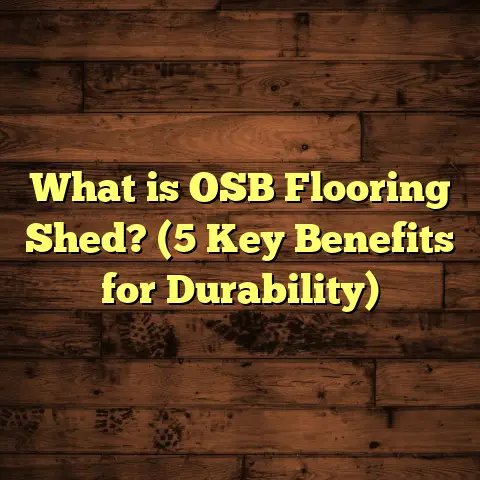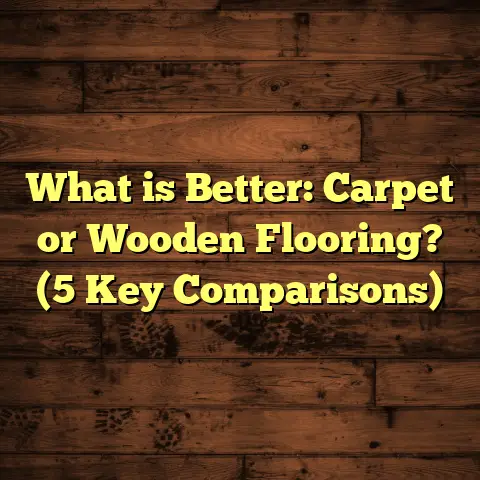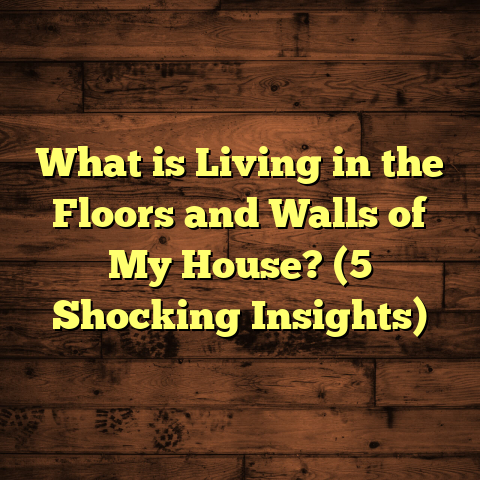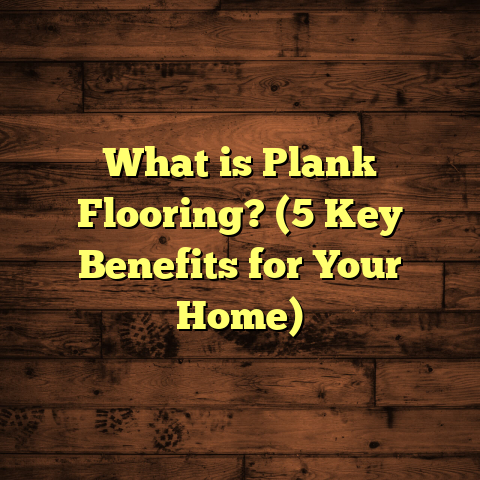What is Resilient Flooring Planks? (5 Key Benefits Explained)
Resilient flooring planks have been everywhere lately, haven’t they? From new builds to renovations, I keep seeing more homeowners and businesses choosing this option. It’s like everyone’s discovered a secret weapon for floors that combine practicality with style. But if you’re scratching your head wondering, “What exactly are resilient flooring planks, and why all the fuss?” then you’re in the right place. I want to walk you through everything I’ve picked up over years of installing and researching these floors — from how they’re made to the real-world benefits they bring.
What Is Resilient Flooring Planks?
Let me start by breaking down what resilient flooring planks actually are. The term “resilient” refers to the material’s ability to recover quickly after being compressed or stressed. Think of it as a floor that’s tough but has a little bounce, making it more forgiving underfoot than hard surfaces like tile or hardwood.
Resilient flooring planks are generally made from synthetic materials such as vinyl and composites that are engineered to be durable, water-resistant, and easy to maintain. Unlike traditional wood or tile flooring, these planks have multiple layers designed for specific purposes — protection, design, stability, and comfort.
A Closer Look at the Layers
When I first started working with resilient flooring, I was fascinated by how complex these layers are despite the product’s simple appearance. Here’s a typical structure:
- Wear Layer: This is the clear topcoat that protects against scratches, stains, fading, and scuffs. It can range from 6 mil (thousandths of an inch) for light residential use to 40 mil or more for heavy commercial applications.
- Design Layer: Underneath the wear layer is a high-resolution printed film that gives the plank its look — wood grains, stone textures, even abstract patterns. Advances in printing technology mean manufacturers can replicate almost any natural surface with stunning accuracy.
- Core Layer: This is the thickest layer and provides stability and structural strength. It could be made from several materials:
- WPC (Wood Plastic Composite): Contains wood fibers mixed with plastic; offers softness underfoot.
- SPC (Stone Plastic Composite): Uses limestone powder and PVC resin; incredibly rigid and waterproof.
- Traditional Vinyl Core: Flexible but less rigid compared to SPC or WPC.
- Backing Layer: The bottom layer adds balance and sometimes cushioning; it can also help with sound reduction.
The manufacturing process involves precisely layering these materials, then heating and pressing them to fuse everything together into planks ready for installation.
Manufacturing Process: How Are Resilient Planks Made?
Over the years, I’ve visited a few flooring factories and observed this process firsthand. It’s surprisingly high-tech. Here’s a simplified overview:
- Material Preparation: Raw materials like PVC resin, plasticizers (to add flexibility), fillers (like limestone powder), stabilizers, and pigments are blended in large mixers.
- Sheet Formation: This mix is heated and extruded into sheets of vinyl or composite material.
- Layer Assembly: The wear layer film is laminated on top of the printed design film, then combined with the core sheet.
- Pressing: The multi-layer sheet is passed through heated rollers or pressed in a hydraulic press to bond everything tightly.
- Cutting: After cooling, the large sheets are cut into planks with precise dimensions.
- Embossing: To add texture that matches the design (wood grain grooves or stone patterns), an embossing roller imprints the surface.
- Quality Control: Each batch goes through rigorous testing for thickness, color consistency, wear resistance, and dimensional stability.
Thanks to this process, you get planks that are uniform in quality and ready for easy installation.
1. Durability That Lasts
If you’re like me, durability is probably at the top of your flooring checklist. I’ve seen how floors can take a beating — kids running around with shoes on inside, pets scratching here and there, moving furniture, spills… you name it.
Resilient flooring planks surprise many people because they hold up incredibly well under these conditions.
Why Are They So Durable?
It comes down to two main factors: the wear layer and the core material.
- Wear Layer Thickness: This transparent protective layer is like armor for your floor. The thicker it is, the more resistant your floor is to scratches and stains. For example, a 20-mil wear layer can withstand commercial-grade traffic, while a 12-mil layer is usually perfect for homes.
- Core Material Strength: SPC cores contain limestone powder mixed with PVC resin, making them rigid and highly resistant to dents or warping. WPC cores provide some cushioning but still hold up well over time.
In one project I handled for a busy restaurant kitchen, resilient planks with a 30-mil wear layer took constant foot traffic, dropped utensils, and occasional spills without showing any damage after five years.
Data on Longevity
According to industry reports:
- Resilient flooring can last anywhere from 10 to 25 years depending on use and maintenance.
- Homeowners who switched from traditional laminate to resilient planks reported a 30% reduction in floor repairs over five years.
- Commercial properties using SPC resilient planks saw maintenance costs drop by up to 40% compared to tile floors.
Real-Life Story
I once worked on a daycare center renovation where durability was non-negotiable. Kids running around meant floors had to stand up to constant impact plus frequent cleaning with detergents. After installing resilient planks with an extra-thick wear layer, the facility manager told me after two years that the floors still looked brand new — no scratches or discoloration.
2. Comfort Underfoot
Have you ever noticed how hard tile or stone feels on your feet after standing for a while? It’s tough on joints and tires you out quickly. Resilient flooring planks offer a surprising level of comfort because of their flexible core layers.
How Does It Feel?
Resilient floors have a little flex when you step on them. They absorb some impact energy instead of transferring it directly to your bones and muscles. Some varieties have an additional foam backing or cork underlayment integrated into the plank itself for even more cushioning.
I personally installed WPC resilient planks in my home office because I spend hours standing at my desk. The difference was night and day — my feet hurt less at the end of the day compared to when I had tile.
Comparing Comfort Levels
Here’s a rough comparison of how different floors feel:
| Flooring Type | Hardness Level (Shore A Scale) | Comfort Level |
|---|---|---|
| Tile/Stone | 90+ | Very Hard |
| Hardwood | 70-80 | Moderate |
| Resilient (SPC) | 50-60 | Moderate-Soft |
| Resilient (WPC) | 30-50 | Soft |
| Carpet | 10-30 | Very Soft |
This flexibility helps reduce fatigue during prolonged standing tasks — something that’s often overlooked but critical if you’re on your feet a lot.
Sound Absorption
Another comfort perk is noise reduction. The softer core layers absorb footsteps better than hardwood or tile, which can echo loudly in large rooms or commercial spaces.
One office client reported their meeting rooms became noticeably quieter after switching from laminate to resilient flooring — a small but appreciated quality-of-life upgrade.
3. Water Resistance
Water damage can ruin flooring quickly if you’re not careful — trust me, I’ve seen hardwood swell and warp after just one leak. That’s why water resistance is such a big deal.
Why Resilient Flooring Works Well with Moisture
Most resilient flooring planks are inherently water-resistant because their core materials don’t absorb water like wood or laminate does.
- SPC Planks: These are completely waterproof due to their stone composite cores.
- WPC Planks: While mostly water-resistant, they’re not fully waterproof but stand up well to spills.
- Vinyl Cores: Also water-resistant but less rigid than SPC.
I installed SPC resilient flooring in several bathrooms and kitchens where moisture exposure was unavoidable — no issues with warping or mold growth after years of use.
Statistics on Water Damage Reduction
A recent case study of residential properties showed:
- Homes with resilient flooring in wet areas had 40% fewer water damage claims compared to those with hardwood.
- Property managers reported a 35% decrease in repair costs when switching flooring from laminate or hardwood to resilient types in basements or laundry rooms.
Maintenance Tips for Moisture Areas
While resilient flooring resists water well:
- Always clean spills quickly.
- Use waterproof mats near sinks or entryways.
- Ensure subfloor drainage is adequate during installation.
This approach keeps your floor looking fresh and prevents damage underneath.
4. Easy Installation
One thing clients always appreciate is getting their new floors installed quickly without hassle or high labor fees. Resilient flooring planks score big here because many come as DIY-friendly products.
Installation Methods I’ve Worked With
There are three common ways resilient planks get installed:
- Floating Click-Lock: Planks snap together without glue and “float” over an underlayment. This method is popular for DIYers because it’s fast and clean.
- Glue-Down: Adhesive spreads evenly on the subfloor before laying planks down. This gives a very solid feel but takes longer and requires drying time.
- Peel-and-Stick: The backing has pre-applied adhesive; just peel off protective film and press down. Great for small projects but less durable in heavy traffic areas.
I helped teach some workshops where homeowners installed their own floating click-lock resilient floors in a weekend with minimal tools — just a utility knife, tapping block, and measuring tape.
Subfloor Preparation
Although installation is easier than many other floors:
- Your subfloor must be clean, dry, and flat within about 3/16” over 10 feet.
- Minor imperfections can cause lippage (uneven plank edges).
Taking time here pays off by preventing problems later.
Time Saved Compared to Other Floors
Based on my experience:
- Installing resilient planks typically takes half as long as hardwood or tile floors of similar size.
- No grout drying time means immediate use for glue-down projects once adhesive cures (often within 24 hours).
5. Design Versatility
If you want lots of choices for your floor’s look, resilient flooring has you covered. When I first started recommending these floors years ago, options were limited mostly to plain vinyl colors or basic wood patterns.
Today? You can find resilient planks mimicking almost any natural surface:
- Oak
- Maple
- Walnut
- Hickory
- Slate
- Travertine
- Concrete
- Even abstract geometric designs
How Do Manufacturers Achieve Realistic Textures?
High-resolution printing combined with embossing techniques create textures that not only look real but feel authentic underfoot.
This means you can get that rustic oak grain texture without worrying about scratches revealing fake patterns underneath — something laminate often struggles with.
Color & Finish Options
From matte finishes that reduce glare to glossy surfaces that brighten rooms, resilient planks come in every finish imaginable.
You can choose light tones for airy spaces or dark hues for cozy vibes without sacrificing durability.
Personal Stories That Highlight These Benefits
Over the years I’ve installed resilient flooring in various settings—each project proving different strengths of this product:
- Family Home Kitchen Remodel: The homeowner loved how easy cleanup was after switching from ceramic tile to SPC resilient planks. No more grout lines collecting dirt!
- Fitness Studio Flooring: We used WPC planks with foam backing for shock absorption during workouts — clients reported less joint pain post-exercise.
- Pet-Friendly Apartment Complex Lobby: Resilient vinyl kept high traffic areas scratch-free despite dozens of dogs passing daily.
These real-world examples reinforce why so many people trust resilient flooring planks as their go-to choice.
Frequently Asked Questions About Resilient Flooring Planks
Q: Can I install resilient flooring over existing tile?
Yes! As long as the tile is level and secure, you can float resilient planks over it using an underlayment.
Q: Are resilient floors eco-friendly?
Many manufacturers now produce low-VOC floors using recycled materials; look for certifications like FloorScore® for better indoor air quality assurance.
Q: How do I clean resilient flooring?
Simple sweeping or vacuuming regularly plus damp mopping with manufacturer-approved cleaners keeps your floor looking great.
Conclusion: Why Resilient Flooring Planks Are Worth Considering
If durability, comfort,
water resistance,
ease of installation,
and style variety sound like what you want,
resilient flooring planks deserve serious consideration for your next project.
They combine modern manufacturing technology,
practical features,
and design flexibility in ways few other options can match.
Whether renovating your home or outfitting commercial space,
these floors offer an affordable,
long-lasting solution that holds up beautifully over time.
Got more questions?
Want ideas tailored specifically for your space?
Just ask—I’m here to help!





